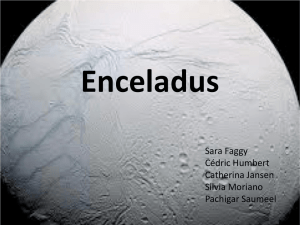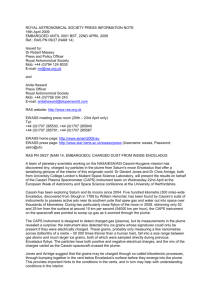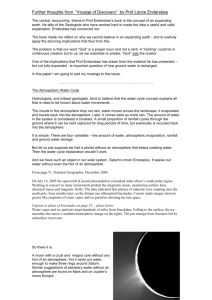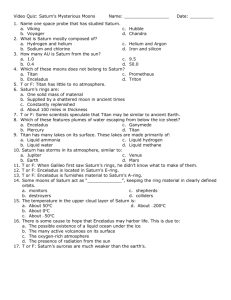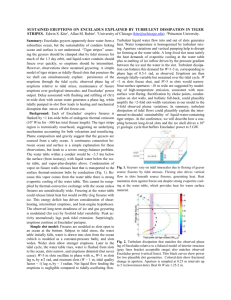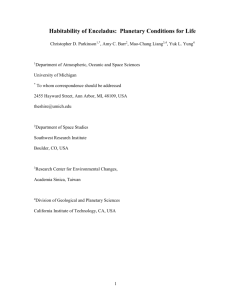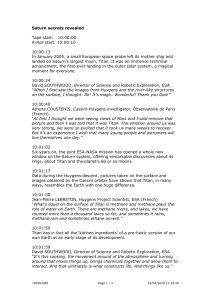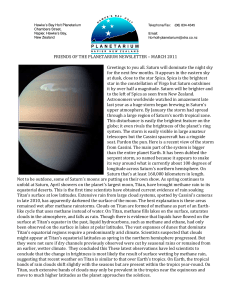DOC
advertisement
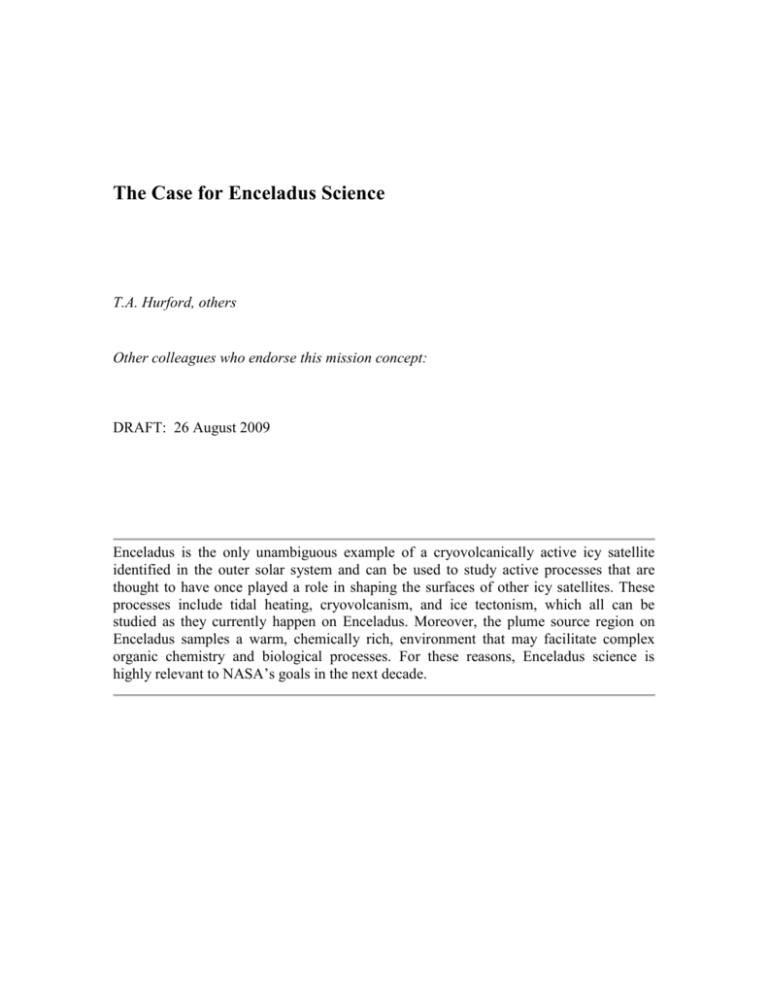
The Case for Enceladus Science T.A. Hurford, others Other colleagues who endorse this mission concept: DRAFT: 26 August 2009 Enceladus is the only unambiguous example of a cryovolcanically active icy satellite identified in the outer solar system and can be used to study active processes that are thought to have once played a role in shaping the surfaces of other icy satellites. These processes include tidal heating, cryovolcanism, and ice tectonism, which all can be studied as they currently happen on Enceladus. Moreover, the plume source region on Enceladus samples a warm, chemically rich, environment that may facilitate complex organic chemistry and biological processes. For these reasons, Enceladus science is highly relevant to NASA’s goals in the next decade. 1. Introduction Enceladus has taken its place as one of the most remarkable moons in the solar system. When Voyager encountered Enceladus it was noted that its surface showed signs of recent activity with the observations of a large province, which was characterized by smooth sparsely cratered terrain (Smith et al. 1982). Even the heavily cratered areas of Enceladus showed a lower crater density than other Saturnian satellites. Moreover, its extraordinarily high albedo hinted at past cryovolcanic resurfacing events. Ground-based observations further demonstrated that Saturn’s diffuse E-ring is concentrated at the orbit of Enceladus (Baum et al. 1980), making the moon the likely source of E-ring particles. However the short estimated lifetime of E-ring particles requires that new particles must constantly be fed to the E-ring, implying more recent activity on Enceladus. Recently, in 2005 the Cassini spacecraft provided definitive proof that Enceladus is currently geologically active when multiple Cassini instruments detected plumes of gas and ice particles emanating from a series of warm fractures centered on the south pole, dubbed the “tiger stripes.” Enceladus is the second cryovolcanically active icy satellite that has been identified (Triton is the only other known active icy satellite but the process driving the cryovolcanism may not be linked to an internal heat source) and can be used to study active processes that are thought to have once played a role in shaping the surfaces of other icy satellites. These processes include tidal heating, cryovolcanism, and ice tectonism, which all can be studied as they currently happen on Enceladus. Moreover, the plume source region on Enceladus samples a warm, chemically rich, environment that may facilitate complex organic chemistry and biological processes. For these reasons, Enceladus science is highly relevant to NASA’s goals. In this white paper, we will outline important science questions regarding Enceladus and show the link between these science questions and major themes of exploration as identified by NASA. 2. Major Science Themes and Questions 2.1 Habitability A driving force in planetary exploration has been the search for extraterrestrial habitable environments in the last decade. In the 2006 Solar System Exploration Roadmap two of the major themes identified for planetary science are: “What are the characteristics of the solar system that led to the origin of life?” and “How did life begin and evolve on Earth and has it evolved elsewhere in the solar system?” Enceladus is arguably a place in the solar system where exploration is most likely to find a demonstrably habitable environment and evaluating its biological potential should be an overarching goal of Enceladus research. Evaluation of the Enceladus’ habitability involves understanding nearly all other aspects of Enceladus science, so much will be learned even if the conclusion reached is that Enceladus cannot support life as we currently understand it. Despite its small relative size, there are reasons to suspect that life might have evolved and could be supported on Enceladus. Oxidation/reduction reactions provide the only known chemical process to drive a biosphere (Gaidos et al., 1999). In terms of supporting redox-based life both a reducing agent and an oxidizing agent must be present. It is not 1 difficult to find a reducing agent for driving a biosphere on Enceladus. The reduction of Fe and Ni-bearing dust particles, which accreted into the cores of proto-planets, occurred in the ancient solar nebula, providing all solid bodies in the solar system with a reducing agent may be exploited by life. Gaidos et al. (1999) noted that for Europa, the availability of oxidants is the primary factor that may make life in its ice-covered ocean difficult, but Parkinson et al. (2007) note that the oxidant supply on Europa may pale in comparison with that of Enceladus. Although the production of oxidants per unit area on the surfaces of the two bodies should be roughly the same, the presence of the E-ring allows particles to be charged through the exposure to energetic particles and UV radiation in the space environment, producing an oxidizing agent that could provide sufficient oxidants for biological processes on Enceladus. The reducing and oxidizing agents need only to be mixed by some suitable geological process. On Enceladus, the chemical composition of materials in the plume and on the surface suggests the presence of a heat source hot enough to decompose ammonia into N2 and drive reactions with hydrocarbons, implying internal temperatures on the order of 500-800 K. In turn, this suggests some form of silicate volcanism presumably driven by tidal interactions (Matson et al. 2007). A volcanic source near Enceladus’ south pole, and a substantial body of water in an ice-covered ocean, is also consistent with the moon’s shape and inferred true Polar Wander events which would have moved this effective negative mass anomaly to the body’s spin axis (Collins and Goodman 2007; Nimmo and Pappalardo 2006). Coupled with the presence of an active ice cycle as indicated by the plumes themselves (Hurford et al. 2007b; Nimmo et al. 2007) this also argues for an enhanced biological potential for Enceladus in comparison with Europa. 2.1.1. Habitability Science Questions: Specific questions relevant to the goal of understanding habitability on Enceladus include: Is liquid water present on Enceladus, either in a subsurface ocean, in the plume vent regions, or elsewhere? How extensive and long-lived is the water, if present, and what is its chemistry? How does the liquid reservoir communicate with the surface? How thick is the ice crust? How uniform is that thickness? What energy sources are available for life? Is life present there now? 2.2. Enceladus’ Origin Another theme driving science exploration is: “How did the Sun’s family of planets and minor bodies originate?” Better knowledge of the present-day interior and thermal structure of Enceladus as well as its composition will give information about the initial stages of its formation. Water ice occurs in both crystalline and amorphous forms over much of Enceladus’ surface. CO2 has been unambiguously detected by Cassini VIMS both as free ice and complexed with another material (Brown et al. 2007). Evidence for low concentrations of short-chain organic molecules in the ice is strong, especially near the tiger stripes (Brown et al. 2006), and other absorption features have been observed that have yet to be identified. Curiously, carbon monoxide and ammonia have not yet been seen, though they are predicted by several lines of reasoning, including their possible role in producing the 2 plume through melting point depression. Other compounds have been observed in the plume and provide clues as to the composition of Enceladus’ interior. Silicates have not been identified, though Enceladus’ high density of 1608 kg/m3 suggests a high silicate/ice ratio. The silicate inventory of Enceladus is important; it implies the presence of 26Al during Enceladus’ formation, which would have provided a method to heat the satellite and affect its internal mass distribution and the material properties (Castillo-Rogez et al. 2007). The distribution of mass, its composition and material properties within Enceladus will control its subsequent orbital and thermal evolution, which are coupled via the effects of tidal dissipation (Showman et al. 1997). Enceladus’ is likely differentiated with an icy shell ~90 km thick, surrounding a silicate core (Barr and McKinnon 2007; Schubert et al. 2007). The heat flux from Enceladus’ south polar region is ~6 GW based on CIRS observations (Spencer et al. 2006). Since radiogenic heating within Enceladus’ rock component supplies only ~0.3 GW (Schubert et al. 2007), tidal dissipation is the likely source of the rest of the heat. The amount of tidal heating depends on the interior structure of Enceladus; it must be warm and/or partially liquid to experience significant tidal flexing and dissipation. Moreover, observations that many ancient impact craters on Enceladus show clear evidence of viscous relaxation provides evidence that a high heat flux has been present for long periods (Passey 1983; Smith et al. 2007; Schenk and Moore 2007). Measurements of Enceladus’ tidal heat flux are the only quantitative constraints on the amount of tidal dissipation and its spatial localization in any icy satellite. 2.2.1 Enceladus’ Origin Science Questions Understanding the interior structure and composition of Enceladus is key to constraining the conditions under which it formed. Important questions that yield information on its origin are: Is Enceladus fully differentiated? What is its bulk composition? What is the distribution of mass within the satellite? How do material properties differ within it? Is there a liquid layer present? Are ammonia, methanol, chloride salts, or some other materials depressing the melting point and enabling a liquid layer or changing rheological properties within Enceladus (even small amounts of contaminants can change rheological properties by orders of magnitude)? How is heat generated within its interior? How is that heat transported? What is Enceladus’ heat flow and how is that heat flow distributed? These questions also support investigation into the previous theme on Enceladus’ habitability. 2.2. Enceladus’ Evolution The final major theme that Enceladus can address is: “How did the Solar System evolve to its current state?” Enceladus is a currently active icy satellite and we can study the processes, as they still operate, that have acted on its surface and helped it evolve to its current state. These processes are also thought to have occurred on other icy satellites. Thus, Enceladus can serve as a Rosetta stone to better understand the histories of other icy satellites in the Solar System. The most remarkable known aspect of Enceladus is its south polar plume activity (Hansen et al. 2006; Waite et al. 2006; Porco et al. 2006; Dougherty et al. 2006; Srama et 3 al. 2006). This is the only unambiguous example of active cryovolcanism in the solar system. The plumes arise from warm surface fractures (Spencer et al. 2006), the “tiger stripes” (Porco et al. 2006). Sublimation of warm surface ice (Spencer et al. 2006), boiling of near-surface liquid water (Porco et al. 2006), decomposition of clathrates at depth (Kieffer et al. 2006), and sublimation at depth due to frictional heating (Nimmo et al. 2007) have all been proposed as plume generation mechanisms. The surface fractures radiate 6 GW (Spencer et al. 2006) and the plume latent heat carries away another ~1 GW, and this energy must be continually resupplied by some heat source. Characterization of the plume is crucial to understanding the mechanism that maintains their activity. Currently ice particle production and escape rates are poorly constrained because of limited knowledge of the plume particle size distribution (Porco et al. 2006; Spahn et al. 2006). However, the mass production rate of the plume gas has been estimated to be ~150 kg/s from occultation data (Tian et al., 2006). This value is surprisingly high, sufficient to remove a significant fraction (~20%) of Enceladus’ mass over the age of the solar system (Kargel et al. 2006). Tectonic features dominate the surface, and have many intriguing similarities to, and differences from, tectonic features found on other icy satellites. Cassini images have revolutionized the Voyager view of this satellite, demonstrating, for instance, that “smooth terrain” is pervasively tectonized (Helfenstein et al. 2005; Rathbun et al. 2005). Several different tectonic processes seem to have been at work. The sinuous chain of scarps that bound the south polar terrain at a latitude of ~55 °S appear to have formed in response to compressional forces, while north-trending fracture zones that radiate from peculiar Y-shaped cusps and interrupt the chain of scarps appear to be extensional (Helfenstein et al. 2006a; Porco et al. 2006). Shear offsets along pre-existing rifts are also observed near the transition between these contractional and extensional features. The origin of the “tiger stripes” is currently unclear. While the south polar terrain is a focus of pervasive active tectonism, other regions are less so (e.g., the cratered north polar region). Analysis of the relationship between impact craters and tectonic features (Barnash et al. 2006; Bray et al. 2007) indicates that the tectonism has persisted through time. Furthermore, fossil terrains elsewhere on Enceladus reminiscent of the south polar terrain suggest multiple resurfacing episodes throughout the satellite’s history (Helfenstein et al. 2006b; Schenk and Seddio, 2006). The chain of scarps bounding the south polar terrain, as well as the northward-radiating fracture zones, may be the product of a change in Enceladus’s global figure, possibly associated with a wholesale reorientation of the satellite (i.e., polar wander). The correspondence of the south polar terrain with a rotational pole is not likely coincidental, and models that seek to explain the south polar activity (Nimmo and Pappalardo, 2006; Collins and Goodman, 2007) often incorporate a long-wavelength low in the equipotential surface of Enceladus that can drive polar wander. Last, the shape of the satellite is changed on a daily basis because of tidal working due to its orbital eccentricity. The apparent morphology and orientation of at least one tiger stripe could be a result (Hurford et al. 2007a), and tidal flexing may play an important role in creating the vapor plumes issuing from the tiger stripes, in general (Nimmo et al. 2007; Hurford et 4 al. 2007b). 2.2.1. Enceladus’ Evolution Science Questions Understanding the current geological activity of Enceladus and the formation of its surface geology are key to understanding Enceladus’ evolution since its formation. Important questions are: What is the plume generation mechanism? How long has this mechanism been active? What are the physical and chemical conditions in the plume and its sources? What are the plume characteristics, particle masses, size and velocity distributions? What are the escape and resurfacing rates? Do plume productions rates vary temporally? Do the source regions migrate along the tiger stripes? Is there low-level plume or other cryovolcanic activity occuring at locations other than the south polar terrain? What is the nature of the formation of tectonic features? Why to tectonic patterns vary over the surface of Enceladus? What is the source of stress driving tectonic formation? How much tidal deformation occurs on Enceladus? How large are tidal stresses induced on Enceladus’ surface? How is the formation of features on Enceladus linked to the formation of features on other icy satellites? These questions also support investigation into the previous themes on Enceladus’ habitability and origin. 3. Importance of Enceladus Science Enceladus may hold the key to understanding other icy satellites. Indeed, many tectonic features on Enceladus may be analogous to features observed on other icy satellites such as Europa, Ganymede, and perhaps Titan. Thus, study of the tectonics of Enceladus, which is probably currently active, can be used as a natural laboratory to investigate the 5 response to stresses of the other icy surfaces of the outer solar system. Moreover, Enceladus possesses a warm, chemically rich, environment that may facilitate complex organic chemistry and biological processes. In fact, in the 2006 Solar System Exploration Roadmap NASA has denoted that the targets in both the Jupiter and Saturn system can make major contributions to our knowledge in the major themes identified in that report (Fig. 1). It is arguable that a Saturn-Enceladus mission can make just as much of a contribution to addressing these science themes as a Jupiter-Europa mission. 4. Recommendations to Consider We would like to make the following recommendations for the panel to consider: Acknowledge that Enceladus can make major contributions to answering some of the fundamental questions we have about the solar system, its formation and evolution and the likelihood that other habitable environmental niches occur outside the Earth’s biosphere. Identify Enceladus as an active icy satellite that provides a unique opportunity to study processes thought to be important in modifying the surfaces of other icy satellites in the outer solar system. Further study of Enceladus can make major contributions to important themes of inquiry identified by past and hopefully future roadmaps on space science exploration. 6 5. References Barnash et al. 2006. Barr and McKinnon. 1007. Baum et al. 1980. Bray et al. 2007. Brown et al. 2007. Brown et al. 2006. Castillo-Rogez et al. 2007. Collens and Goodman. 2007. Dougherty et al. 2006 Gaidos et al. 1999. Hansen et al. 2006. Helfenstein et al. 2006a. Helfenstein et al. 2006b. Helfenstein et al. 2005. Hurford et al. 2007a. Hurford et al 2007b. Kargel et al. 2006. Kieffer et al. 2006. Matson et al. 2007. Nimmo et al. 2007. Nimmo and Pappalardo. 2006. Parkenson et al. 2007. Passey. 1983. Porco et al. 2006. Rathbun et al. 2005. Schenk and Moore. 2007. Schenk and Seddio. 2006. Schubert et al. 2007. Showman et al. 1997. Smith et al. 2007. Smith et al. 1982. Spahn et al. 2006. Spencer et al. 2006. Srama et al. 2006. Tian et al. 2006. Waite et al. 2006. 7

